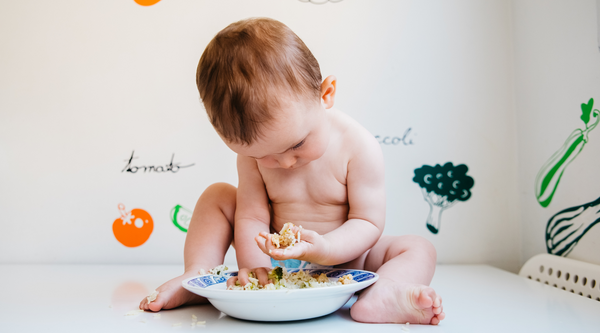Introducing Solids to your Baby: When, What, and How

WHO recommends that a baby should be exclusively breastfed for the first six months of their life. Mothers who choose to feed formula milk or introduce top feed should also continue this for six months. However, once the baby reaches the six-month mark, it’s time to slowly introduce solid food.
Here’s everything you need to know about introducing new food groups to your child.
When should you start solids for your baby?
It is recommended that you introduce solids at six months of age. However, it is not a strict rule to start solids as soon as your baby is six months old. Some babies begin to accept solid food and wean themselves. That is, they reduce their intake of breast milk.
At the same time, many babies continue to rely on breast milk as their main source of food even beyond six months. So it’s best to follow your baby’s pace when it comes to introducing solids.
How to know when your baby is ready to start solids?
Below are some of the signs a baby will show that indicates he is ready to start solid food.
- Baby shows interest in the food that everyone around him eats.
- The baby can sit up straight with some support in a chair and can raise his head on his own.
- The baby opens his mouth for a new food or a spoonful of food and closes his mouth when the food has entered.
- The baby shows interest by chewing new foods that you give him.
- The baby is eager to eat more food even after their regular feeding (breastmilk or formula).


What to do if the baby is not ready to start solids?
If your baby is not ready to start solid food, he will indicate this by refusing new foods. He may not open his mouth when you bring new food or a spoon near him. He may also not swallow the food and may try to spit it out.


If this happens, don’t worry. Some babies take time to accept new tastes and textures. Do not force feed the baby. However, keep trying to introduce solids every few days until the baby starts showing interest. It also helps to have the baby sit with the family at the dinner table so they can see everyone around them eating food.
Remember, mommy, that the goal at this point is not to feed baby lots of solid food but to help him understand more about food and help him develop a healthy relationship with food.
What should you feed your baby when starting solids?
When baby is just starting solids, soft foods like puree are a good start. You can make purees from vegetables, fruits, cereals, lentils, meat, etc. or experiment with combinations of these food groups.


Fruits such as bananas can be pureed directly. For vegetables like broccoli or a hard fruit like an apple, it’s best to steam and then puree to get a smooth texture. Lentils, rice, chicken, fish, potatoes, etc. must be cooked well before you juice it. It’s a good idea to mix food groups like brown rice and chicken or a mixed fruit juice for some variety.
Experiment with a few different foods until you find combinations that your baby likes.
Be careful to drink while giving solids to your baby
However, remember that the food you prepare for your baby does not need any seasoning – not even salt. Your baby’s taste buds and digestive system are still developing. Therefore, they only need cheap food. Also, while the natural sugars from fruits are good for baby, they don’t need the sugar added to their fruit purees or cereals.


Babies also don’t need much oil at this point. So, when you cook food like vegetables or meat, bake, boil, or just steam. Also remember to remove seeds, pith, or tough skin from vegetables and fruits. The meat you feed your baby should be boned and skinned.
You also need to watch out for any allergic reactions when a baby starts trying new foods. Skin rashes, swelling of the face, mouth, or tongue, vomiting, or diarrhea may be signs that the food does not agree with the baby. If this happens, take your baby to the pediatrician to get a proper diagnosis. You can also stop the food that you think may have caused this reaction.


Some foods to avoid include:
- Fish with high mercury content
- Carbonated drinks
- Foods with artificial flavors, colors, or preservatives
- Uncooked food
- honey
- Processed foods such as cheese that have a high salt content
- Dairy products that are not pasteurized
- Cow’s milk
How to feed solid food to the baby?
Below are some tips to make mealtime fun for your baby. The eating habits your baby develops now can affect their food choices as an adult. Therefore, it’s a good idea to keep mealtimes fun and stress-free.


- Babies thrive on routine. If you can set a mealtime routine for baby, he’ll know when it’s time to eat and he’ll be more receptive to the new tastes and textures you introduce him to.
- Getting a high chair for the baby is a good idea. A high chair allows the baby to be strapped in and therefore gives him the opportunity to focus on eating without too many distractions. It also helps the baby sit up straight while eating, thus preventing the risk of choking.
- Do not force feed the baby. Also, don’t use distractions to feed the baby.
- Keep mealtimes relaxed and be patient with baby. Let him take his time eating and experiencing the food and don’t rush to finish his meal.
- Take cues from the baby to understand how much food he needs. Babies rarely overeat; so if baby stops eating, it means he is full.
Should you stop breastfeeding when you introduce solids?
Introducing solids doesn’t mean you have to stop breastfeeding. You should continue breastfeeding as long as you and the baby want. Breast milk is high in nutrients and antibodies and will continue to provide good nutrition to your baby even after they start eating solids.


Final thoughts
Your baby knows what he wants. So, by all means, introduce solids at six months. But take cues from your baby to understand when he is ready. At six months, your baby will still rely on breast milk for his nutritional needs. So continue to augment regular feeds with solid food.
As the baby shows signs of preferring solids, gradually start increasing the amount of solids, while also supplementing with breast milk according to the baby’s needs.
Are you enjoying this post?
Feel free to share this with any mom. Join the community of moms today and receive weekly motherhood tips and tricks straight to your inbox. From time to time, we’ll send you updates on new launches and exclusive events, and you’ll always be the first to know.
Shop the Lovemère collection today.





